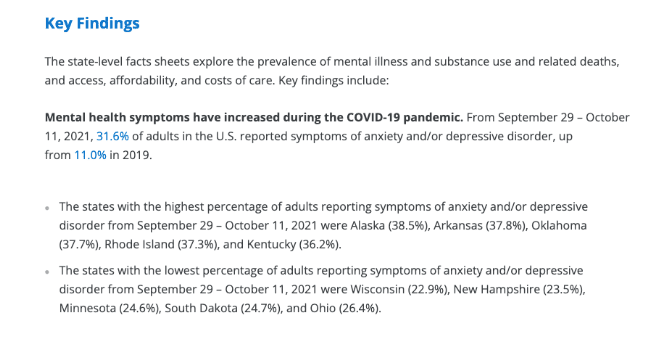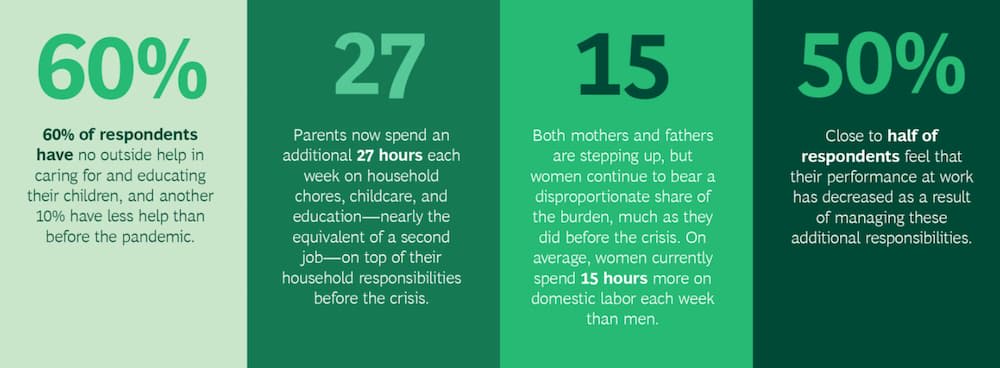The 2020s is already a decade for the record books. As a society, we’ve experienced a global pandemic, renewed uprisings around racial injustice and women’s rights, tumultuous election seasons, and for many, a collision of all of the facets of our lives coming together.
Schools and workplaces have converged at home, and employers are continuing to explore ways to both keep the lights on and keep employees healthy.
All of these things have illuminated the importance of mental health, bringing a topic that isn’t always talked about to the forefront of discussions everywhere. And one thing rings true — like the 2020s, even with the best preparation, there are some things with mental health that we just can’t anticipate.
However, we can absolutely pay attention to, and stay on top of, key mental health trends in both the workplace and our communities as a whole.
Mental Health Trends in The Workplace
First, let’s look at some of the trends in mental health that are becoming more and more prevalent in the workplace.
Employee mental health and well-being is becoming a budget line item
According to data from the Kaiser Family Foundation, 31.6% of adults reported symptoms of anxiety and/or depression in October 2021. From an employer standpoint, mental health challenges can impact retention, productivity, and job performance — not to mention healthcare costs.
Forward-thinking workplaces recognize the benefits of investing in the mental health and wellness of their employees — and data supports this.

In another study conducted by the American Psychological Association, employees at companies that support wellness feel 53% more motivated than employees without that benefit.
Another recent study from Deloitte found that investment in workplace mental health, through the use of digital health apps and peer support workers, has been proven to be effective amongst employees.
Finally, research continues to show that employees who are well — both mentally and physically — have a positive impact on everything from productivity to retention, workplace satisfaction, job performance, and employee engagement.
So, bottom line — not only is prioritizing the well-being of employees a good thing from a people standpoint but from a business standpoint as well. This can come in many forms: counseling resources for employees, availability of apps or technology tools to promote positive employee mental health, the allotment of “mental health days”, or the utilization of workplace mental health education programs.
Promoting Workplace Mental Health In The Age of COVID-19
Employee resource and affinity groups are becoming commonplace
Employees are bringing more “into the office” with them than ever before, and the line between work and personal lives is more blurry than ever before. It’s becoming increasingly difficult to ignore all of the factors which were so easy to compartmentalize in a pre-pandemic world — and many employers have seen this play out in their employees’ states of well-being.
One way that many organizations are mitigating this work-life imbalance is by creating employee resource groups (ERG’s) or affinity groups. These communities are spaces in which employees can connect with others who share similar interests or aspects of an identity. For instance, there are affinity groups for parents, members of the LGBTQI+ communities, those focused on mental health, and affinity groups for women and people of color.
By creating the structure for affinity groups, employers can create space and resources for supporting members of their community, fostering connection, and potentially increasing retention and satisfaction.
Mental Health Trends in The Family
When looking at mental health trends it’s important to understand what impacts employees at the workplace and at home.
Mental health will become dinner table dialogue
Although mental health challenges have risen, so too has dialogue around it. The simple question “how are you?”, typically met with cursory responses, has led many to engage in deeper conversations about their well-being. This is a current mental health trend that has extended into many families.
It is likely that conversations about mental wellness will continue to increase, particularly as we look closely at some of the lingering effects of changes in our society.
By discussing mental health openly, families can proactively address any challenges that may emerge and create space for identifying healthy ways to cope with adversity.
More parenting is happening “out of the shadows”

As many workplaces and schools moved to a remote setting, working parents, in particular, felt a confluence of their identities. According to a 2020 global study of working parents in the US, UK, France, Germany, and Italy, conducted by Boston Consulting Group, 60% of respondents reported that they had no outside help in caring for and educating their children.
From interruptions on Zoom meetings, balancing meetings to accommodate children’s schooling, and navigating unexpected school closures, workplaces and employees alike have found themselves unable to ignore the needs of working parents.
It is critical that employers and employees come together to explore how to best support the working parents within their communities — for instance, flexible scheduling, additional parent-focused benefits, childcare stipends, or caregiving pods.
Mental Health Trends in Education
Finally, understanding mental health trends in education can help us, as a society, create more dialogue and awareness around mental health from the ground up.
An increased prioritization of educator mental health
One of the unsung heroes of the pandemic, in addition to healthcare workers and first responders, has been educators. As parents find themselves in the situation of teaching their kids at home, we see a trending increase in highlighting the importance of educators.
Unfortunately, studies have also shown that decreases have taken place in teacher well-being — which, in many cases, can lead to increased burnout, decreased student satisfaction, and teachers leaving the workforce.
10 Mental Health Tips for Teachers During the COVID-19 Pandemic
As the decade continues, we’ll likely see additional changes take place within our education systems, with many districts recognizing the need for resources to protect their greatest asset — their educators. Professional development funding, structural changes that include teacher mental health care, and support groups are just some of the ways in which schools are focusing on the well-being of teachers — a mental health trend which we will likely (and hopefully) see continue.
An increase in mental health education for students
In 2020, EVERFI researchers explored the impact of COVID-19 on the mental health of 11,000 students. 38% reported that they were more concerned about their mental well-being, and more than half reported feeling more stressed. 35% were more concerned about their use of technology, 47% were more concerned about academic preparedness, and 33% were more concerned about connections to their peers.
These insights highlight the range of challenges and concerns that students are having, and affirms the importance of making sure that schools and communities think holistically about their well-being.
In addition to having the appropriate resources in place to support student mental health, mental health education is another way to ensure that young people have access to the knowledge and skills necessary to maintain positive mental health and cope with challenges.
Summarized in a June 2020 op-ed:
“By investing in mental health education and services, we impact people now because they have the tools they need to manage challenges that may arise later. This, in turn, positively impacts society economically as well as socially. According to the World Health Organization, depression and anxiety cost the global economy $1 trillion a year in lost productivity. For every $1 spent on effective social-emotional learning programming, the return on investment is $11 in long term benefits (to students, communities, and schools).
We require education on a variety of topics to strengthen our intellect: math, science, reading, and social studies. Learning the skills to protect our brain should also be an essential component of education. Integrating an evidence-based mental health curriculum into America’s public schools has the real potential to save lives by enabling teens and adolescents to better recognize mental health issues among themselves and their peers and take steps to get help.”
For more information about how you can bring mental health resources to your community, check out EVERFI’s Mental Wellness Coalition.

